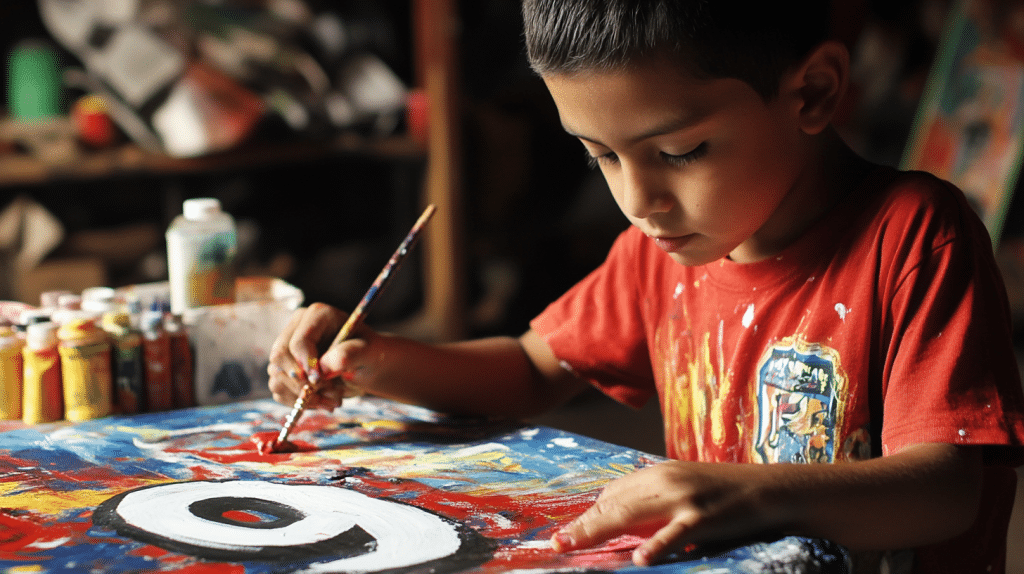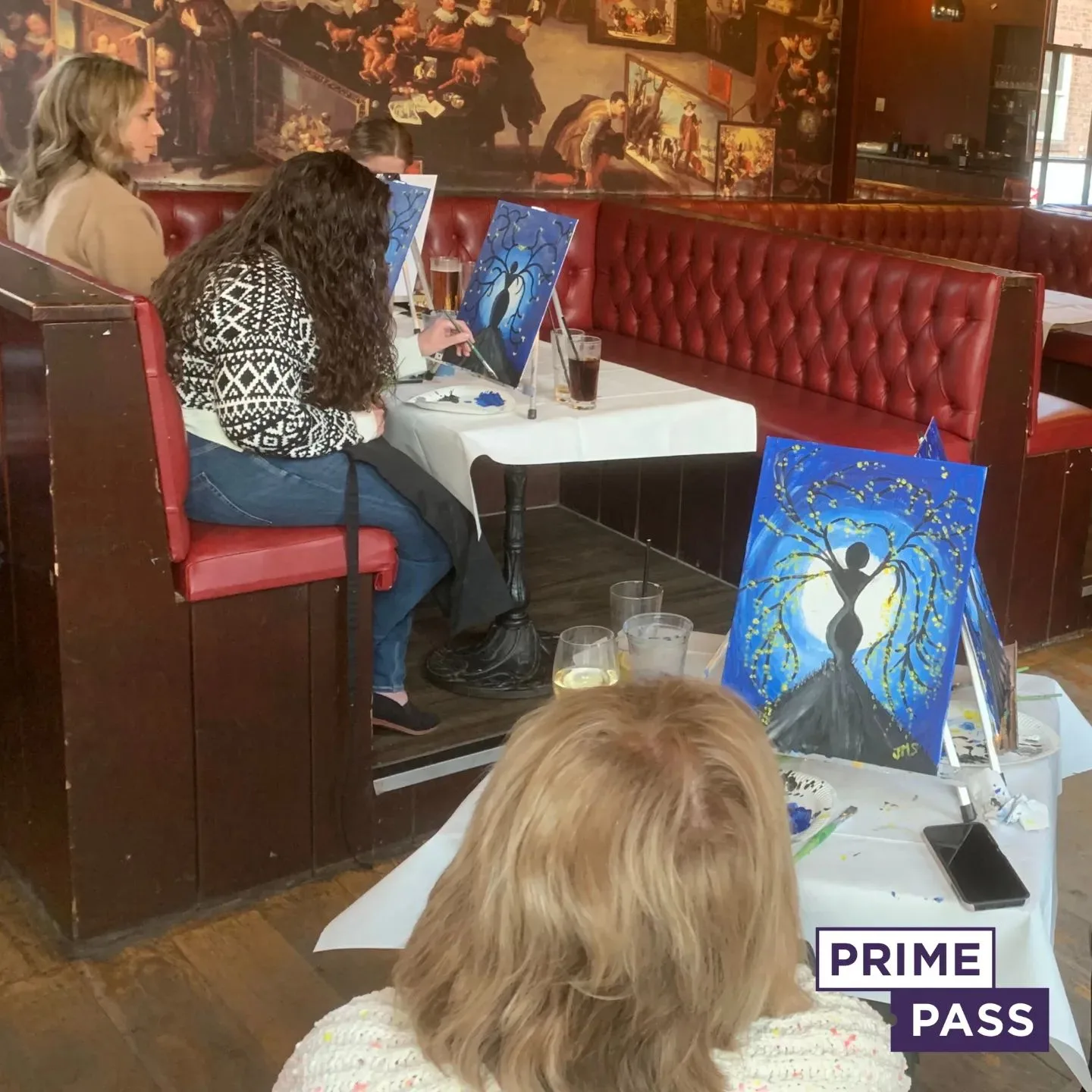Think art is just for the artistic elite? Think again: this powerful, yet underecognised, tool can remarkably reshape your well-being, physically and mentally. As you weave art into your daily rituals, expect a waterfall of calmness, a heightened sense of awareness, and a gentle, guided tour into the depths of your own heart. Whether you’re painting, sketching, or engaging in mindful colouring, the simple act of creating art can help you cultivate a sense of calm and self-compassion. Add art to your self-care mix and watch your well-being bloom.

For those looking to explore creative experiences in art, consider visiting the Painting Event in various locations. This buzzing hub of art and culture is one of the prime locations featured on our website, offering a wide array of painting events and artistic activities that can enhance your self-care journey.
7 Self-Care Benefits of Art:
1. Fosters Creative Expression
Emotions are raw and unbridled, art scoops them up and puts them on display, rendering words unnecessary. Your inner world comes alive through art, as colours, shapes, and patterns form a visual language that both calms and liberates. Mindful art-making is a judgment-free zone, allowing you to put whatever you feel onto your canvas, paper, or digital medium. Emotional release can be the first step towards a breakthrough – by putting your feelings into words, you take the sting out of painful emotions and start to find peace.
2. Boosts Self-Confidence
When you create something with your own hands, it’s like igniting a spark within yourself – your confidence surges, and your self-worth gets a major boost. Your creative expression is like a window into your soul – each piece a reflection of your inner turmoil, passions, and dreams. As your creative muscles flex with each new project, a growing sense of confidence will begin to flourish within you. With confidence came a tsunami of positivity, flooding your personal and professional spheres with calm, clarity, and an unmistakable swagger.
3. Reduces Stress and Anxiety
Whether you’re a skilled artist or a total newbie, making art can help quiet that internal voice that’s always worrying about something. Focusing on the process of creating—whether it’s painting, drawing, or even mindful colouring—can calm your nervous system and help you enter a state of flow. As you surrender to this immersive experience, feelings of panic melt away, replaced by a sense of steadiness. The next time you’re feeling anxious or stressed, try reaching for your art supplies to experience immediate relief.
4. Facilitates Emotional Healing
Art has long been used as a therapeutic tool, and for good reason. Art-making becomes a raw, emotional release when you surrender to the process, letting your inner truth shine through. Healing doesn’t always follow a straight line, but sometimes, the most scrambled, fractured pieces of our stories can be reshuffled into something gorgeous, like the beauty that arises from brokenness. Art therapy is often recommended by professionals as a way to work through emotional pain and foster mental clarity.
5. Promotes Mindfulness
In today’s busy world, finding time for mindfulness can be challenging. Engaging in artistic activities allows you to practice mindfulness without feeling like a chore. As you focus on the movements of your brush or pencil, you become fully immersed in the present, slowing down your thoughts and tuning in to your body’s sensations. When you create with a mindful attitude, negative self-talk begins to fade, replaced by a deeper sense of emotional harmony.
6. Fosters a sense of community and belonging by building stronger relationships.
Artistic pursuits have a way of bringing people together, and fostering connections through creative expression. Whether you join a local art class, participate in a painting event, or simply share your creations online, art helps build relationships. Talking about your art with fellow creatives can lead to some amazing conversations – the kind that help you process your emotions, build creative connections, and even find common ground on mental health issues.
7. Improves Mental Health
Regular art practice can have lasting positive effects on your mental health. Creativity is like a magic pill for your brain – it releases a wave of dopamine that brightens your mood and helps lift the fog of depression, leaving you feeling more balanced and in control. Making art a steady part of your relaxation routine is like keeping a first-aid kit for your mind – it patches up the scrapes and helps you confront life’s surprises with confidence.
7 Ways to Incorporate Art Into Your Self-Care Routine
Now that you understand why art should be part of your self-care routine, here are seven ways to start incorporating it into your daily life:
1. Create a Vision Board
A vision board is a creative way to visualise your goals and dreams. Mindfulness and self-reflection become supercharged with this fantastic tool at your disposal. Gather the treasures that fuel your imagination, write out your deepest desires, and splash them with a kaleidoscope of colours that fill you with energy – before you know it, your visions will start taking shape.
2. Practice Mindful Painting
Mindful painting allows you to fully engage with the process of art-making, focusing on each brushstroke and the feeling it evokes. Bye-bye stress! This mindful exercise hooks you up with a healthy dose of calm, making it the perfect bookend to a busy day that’s left you feeling frazzled.
3. Make an Emotion Wheel
An emotion wheel is a tool that uses colours to represent different emotions. Create your own by assigning a colour to each emotion you frequently experience. Imagine being able to convey the emotions you can’t quite put into words – that’s what this creative process offers, helping you unravel and make sense of your feelings.
4. Design a “No-Send” Postcard
Use art as a way to express thoughts or feelings you want to release without actually sending them to anyone. Write and draw your feelings on a postcard or letter, and keep it as a private expression of self-reflection.
5. Use Calming Colours
Create a painting or drawing using only colours that make you feel calm and happy. Whether it’s shades of blue, soft pastels, or vibrant yellows, focus on what brings you peace. By absorbing ourselves in this art form, anxiety starts to dissipate, replaced by a sense of calm.
6. Try Mindful Colouring
Mindful colouring books are widely available and provide an easy way to enjoy the benefits of art without needing advanced skills. Simply focus on the patterns and colours, and let your mind relax.
7. Attend a Paint and Sip Event
Looking to socialise while also practicing self-care? Attend a paint and sip session. Catch up with friends or make new ones while creating art and savoring your favourite drinks in our laid-back studio setting.
When you combine art with self-care, you’re giving yourself a recipe for wellness that reaches far beyond a simple hobby – it’s a nurturing experience for your entire being. Following these simple tips might just lead you to a surprising realisation: creativity has the power to completely flip your life script.
Having trouble finding peace of mind? Fighting to keep your thoughts from spiraling out of control? If you’re feeling overwhelmed or struggling with your mental health, reach out to your GP or mental health professional for support. A growing number of workplaces now provide access to mental health resources, recognising the importance of supporting employees’ overall well-being.




